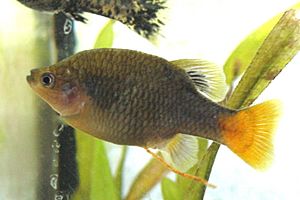Splitfins facts for kids
Quick facts for kids Splitfins |
|
|---|---|
 |
|
| Redtail splitfin, Xenotoca eiseni | |
| Scientific classification |
|
| Kingdom: | Animalia |
| Phylum: | Chordata |
| Class: | Actinopterygii |
| (unranked): | Ovalentaria |
| Order: | Cyprinodontiformes |
| Suborder: | Cyprinodontoidei |
| Family: | Goodeidae Jordan & Gilbert 1883 |
| Subfamilies | |
|
Empetrichthyinae |
|
Goodeidae are a family of fish called splitfins. They live only in Mexico and parts of the United States. There are about 50 different kinds (species) of splitfins. These fish are named after a scientist named George Brown Goode.
Contents
Where Splitfins Live: Their Homes in Mexico and the US
The splitfin family has two main groups: the Goodeinae and the Empetrichthyinae.
Goodeinae: Mexico's Freshwater Fish
Most splitfins, about 45 species, belong to the Goodeinae group. They live in shallow fresh water in Mexico. You can find them especially in the Mesa Central area. This includes places like the Lerma River basin and the Valley of Mexico. Some kinds also live in slightly salty water near the Pacific coast. Others are found north in Durango, Sinaloa, and San Luis Potosí.
Empetrichthyinae: US Desert Dwellers
The Empetrichthyinae group has 4 species. These splitfins live in the southwestern Great Basin in Nevada, United States.
What Makes Splitfins Special: Physical Features
The name "splitfin" comes from a cool feature on the male fish. The front part of their anal fin (the fin on their belly) is partly separate from the rest. This helps them during reproduction.
Splitfins can grow up to 20 centimeters (about 8 inches) long. But most species are much smaller, around 5 centimeters (about 2 inches).
How Splitfins Reproduce: Live Births
Goodeid fish have internal fertilisation. This means the male fertilizes the eggs inside the female's body. The male uses a special part of his anal fin called an andropodium.
Instead of laying eggs, female goodeids give birth to live young. This is called viviparous reproduction. The baby fish grow inside the mother. They have ribbon-like structures called trophotaeniae. These help them get nutrients from the mother's body. The young fish shed these structures soon after they are born.
Protecting Splitfins: Why They Need Our Help
Many splitfin populations have become much smaller recently. This is mainly because of human activities. Things like pollution, too many nutrients in the water (eutrophication), and changes to their homes (habitat modification) hurt them. Also, some places where they live are drying up (desiccation). Experts say about 80% of their natural homes have been lost.
Splitfins are not important for fishing or industry in Mexico. Because of this, people haven't focused much on saving them. But their small size and the efforts of some aquarium hobbyists have led to more research. This research shows how important it is to protect all freshwater fish around the world.
Splitfins at Risk: Conservation Status
Many splitfin species are in danger or have already disappeared. The IUCN and the U.S. Fish and Wildlife Service keep track of them.
- Vulnerable (at risk): bold characodon, darkedged splitfin, Goodea gracilis, Allotoca dugesii
- Endangered (very high risk): bluetail splitfin, rainbow characodon, relict splitfin, Allotoca diazi, Manse Spring killifish
- Critically endangered (extremely high risk): blackspot allotoca, Chapultepec splitfin, highland splitfin, Balsas splitfin, Tequila splitfin
- Extinct in the wild (only found in aquariums): butterfly splitfin, golden skiffia
- Extinct (completely gone): Ash Meadows killifish, Parras characodon, Raycraft poolfish, Pahrump Ranch poolfish
Life Cycle and Evolution of Splitfins
Most Goodeid fish give birth to live young. Some are popular aquarium fish, like the redtail splitfin (Xenotoca eiseni).
Scientists believe this fish family is about 16.5 million years old. Most of their different species appeared during the Miocene period. The many different kinds of splitfins are due to past volcanic and geological changes in their region. These changes created new isolated areas, which helped new species form (allopatric speciation).
Types of Splitfins: Genera
Here are some of the main groups (genera) within the Goodeidae family:
Subfamily Empetrichthyinae – These are called springfishes and poolfishes.
- Crenichthys – springfishes
- Empetrichthys'' – poolfishes
Subfamily Goodeinae – These are the typical goodeids and splitfins.
- Allodontichthys
- Alloophorus – Bulldog goodeid
- Allotoca – typical allotocas
- Ameca – Butterfly splitfin, butterfly goodeid
- Ataeniobius – Striped goodeid, bluetail goodea
- Chapalichthys
- Characodon – characodons
- Girardinichthys
- Goodea
- Hubbsina
- Ilyodon
- Skiffia – skiffias
- Xenoophorus – Relict splitfin
- Xenotaenia – Leopard splitfin
- Xenotoca
- Zoogoneticus
See also
 In Spanish: Goodeidae para niños
In Spanish: Goodeidae para niños

